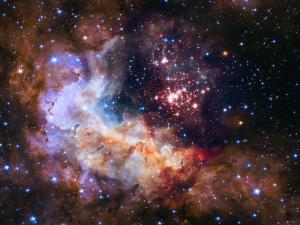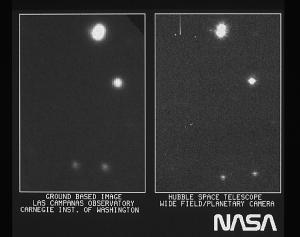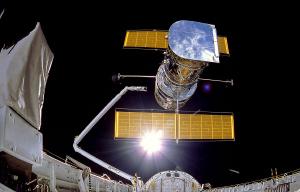Blog
A Whole New World
21 May 2015
 NASA, ESA, A. Nota (ESA/STScI), and the Westerlund 2 Science Team
NASA, ESA, A. Nota (ESA/STScI), and the Westerlund 2 Science TeamTwenty-five years ago the Hubble space telescope took its first image of the heavens. While the first image might not have seemed impressive at first glance, it opened a view of the universe previously unattainable. First Hubble image.
 NASA
NASAThe Hubble telescope had several advantages over ground-based telescopes of the time. To begin with, it didn’t suffer from the atmospheric distortions that cause stars to twinkle. Because of such distortions, ground-based telescopes had a limiting resolution of about a second of arc. The Hubble could gather light to about 0.05 arcseconds. Since Hubble’s launch, ground based telescopes have gained greater precision through interferometry and adaptive optics, but these were years away when Hubble’s mission began. Hubble could also observe infrared and ultraviolet wavelengths, much of which are absorbed by Earth’s atmosphere.
The greater range and precision of Hubble has given us a much deeper understanding of the universe. It allowed us to measure Cepheid variable stars with greater precision, which gave us a more accurate cosmic distance ladder. It found protoplanetary disks in the Orion nebula, confirming the basic model of planetary formation. It gave us the Ultra Deep Field, which found that there are thousands of galaxies in a patch of sky no bigger than a grain of sand. It also gave us thousands of beautiful images, from the Pillars of Creation to the starry ocean of the Andromeda galaxy.
 NASA/IMAX
NASA/IMAXBut perhaps its most revolutionary discovery came from observations of distant supernovae. By measuring the brightness of these supernovae, we could determine their distance. What we found was that the universe is not only expanding, but that the rate of expansion is increasing. This not only gave us an accurate measure of the age of the universe, it also led to the discovery of dark energy, which we are still trying to understand.
The Hubble telescope was named in honor of Edwin Hubble, who played a central role in demonstrating that the universe extended far beyond our Milky Way galaxy. It is perhaps fitting that the telescope bearing his name has done so much to determine the true age and scale of the cosmos.